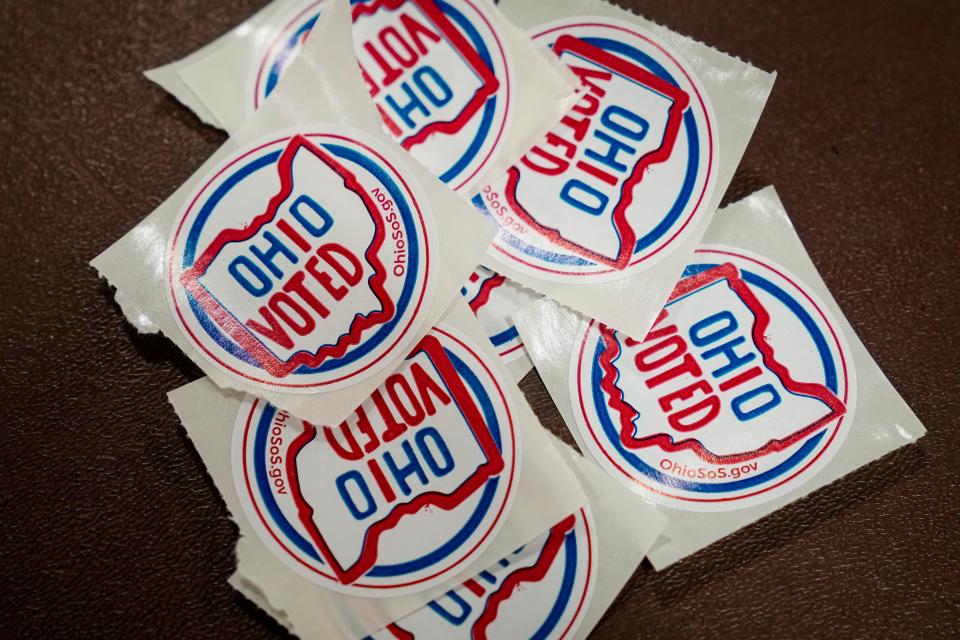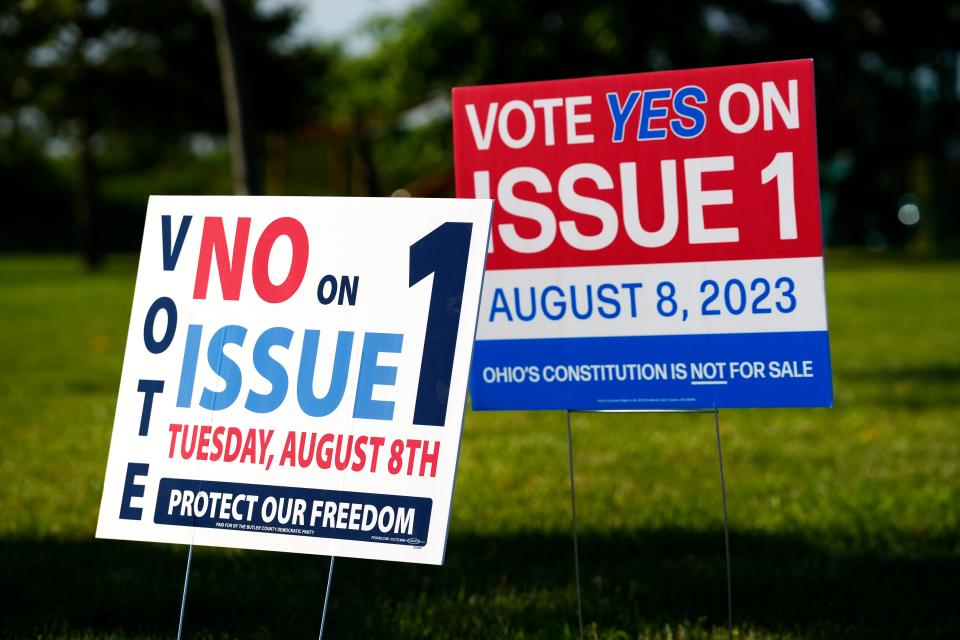Controversial Ohio measure that turned into proxy war over abortion rejected by voters
Ohio voters rejected Issue 1 on Tuesday, dealing a blow to Republicans who wanted to hamstring a November ballot question on abortion rights.
The no vote prevailed 57% to 43% with over 3 million votes cast, according to unofficial results. About 58,000 absentee and provisional ballots were outstanding as of Wednesday.
"Tonight, Ohioans claimed a victory over out-of-touch, corrupt politicians who bet against majority rule, who bet against democracy," Ohio Democratic Party Chair Liz Walters told reporters at an election night gathering in Columbus. "Tonight, Ohioans everywhere have claimed a victory for the kind of state we want to see."
Tuesday’s election was the culmination of a months-long fight that began last year, when Secretary of State Frank LaRose and state Rep. Brian Stewart first introduced a plan to tighten the rules for constitutional amendments. The debate played out in the halls of the Ohio Statehouse, on the campaign trail and even in the courtroom as opponents tried to stop GOP lawmakers in their tracks.
Proponents of the measure said they want to keep controversial policies out of the constitution and reserve it for the state's fundamental rights and values. Critics argued the ballot measure was a power grab that would hamstring the rights of citizens to place an issue on the ballot.
Ohioans appeared to buy the message opponents were selling. "No" votes poured in from progressive strongholds around Columbus, Cincinnati, Akron and Cleveland, but the measure also garnered opposition from voters in key GOP areas.
For example, nearly 58% of voters in suburban Delaware County north of Columbus rejected Issue 1 despite the county's long history of supporting Republicans.

Politics: Abortion rights (and 2024 election playbooks) face critical vote on Issue 1 in Ohio
The fight over Issue 1 generated national attention.
"Today, Ohio voters rejected an effort by Republican lawmakers and special interests to change the state’s constitutional amendment process," President Joe Biden said in a statement Tuesday night. "This measure was a blatant attempt to weaken voters' voices and further erode the freedom of women to make their own health care decisions. Ohioans spoke loud and clear, and tonight democracy won."
Ohio Issue 1 live results
Ohio August election sets stage for abortion fight in November
Tuesday's outcome means it's business as usual for changing the Ohio Constitution. Future proposed amendments will only need a simple majority of the vote to take effect, and there will be no changes to the signature-gathering process for citizen groups.
That's good news for supporters of abortion access, who placed a proposal on the November ballot to enshrine reproductive rights in the constitution. Republicans set the August election to preempt that vote and make it harder for the abortion amendment to pass.
The move turned Tuesday’s election into a nationally watched proxy war over the abortion debate, as Ohio is the only state voting on the issue in 2023.
"Winning in August was vital," said Lauren Blauvelt, vice president of government affairs for Planned Parenthood Advocates of Ohio. "It is important that majority rule is the standard. It is the right that Ohioans had for 100 years. We're not going to give that up."
Opponents of the abortion amendment funneled millions of dollars into the campaign to support Issue 1. Now, they're focused solely on convincing Ohioans to vote no in November − the opposite message they sold for August.
"I think the Republicans that decided to vote no today voted no outside of their positions on abortion, Second Amendment or small businesses," Ohio Right to Life President Mike Gonidakis said. "They'll come home. I don't think the other party is offering them anything that they want to latch on to."

Issue 1 drew heated summer campaign
Even with such high stakes, convincing Ohioans to pay attention to a convoluted political issue in the summer cost both sides millions of dollars.
The One Person One Vote coalition opposing Issue 1 spent roughly $12.4 million on TV, cable and radio advertising, according to ad-tracking firm Medium Buying. The group dominated the airwaves for weeks − much to the chagrin of Issue 1 supporters − but Protect Our Constitution eventually launched ad buys to the tune of $2.5 million.
State Senate President Matt Huffman, a Republican, said supporters of Issue 1 didn't have enough time to educate voters about the issue, even though Republican lawmakers unilaterally set the August election date. And Huffman suggested this question could come before Ohioans again in the future.
"I think it's a question that was worth asking of the voters, not only because of the two issues that are on the ballot in November, but the six to 10 that are planned over the next couple of years," Huffman said.

More: Issue 1 poll: Most Ohio voters oppose plan to make it harder to amend constitution
Both campaigns were largely bankrolled by out-of-state donors, even as they railed against the influence of outside interests. Protect Our Constitution received most of its funding from Illinois billionaire and conservative donor Richard Uihlein, while opponents got substantial help from progressive groups in California and Washington, D.C.
The full cost of the election won’t be known until September, when the campaigns face their next filing deadline.
Their efforts appeared to pay off. Critics of Issue 1 were concerned that turnout would be low, and lawmakers limited August special elections for that very reason. But nearly 642,000 people cast early in-person or absentee ballots, outpacing the early vote turnout for the May 2022 primary. Election Day turnout also exceeded expectations.
Haley BeMiller and Lily Carey are reporters for the USA TODAY Network Ohio Bureau, which serves the Columbus Dispatch, Cincinnati Enquirer, Akron Beacon Journal and 18 other affiliated news organizations across Ohio.
This article originally appeared on The Columbus Dispatch: Issue 1 Ohio results: Measure serving as proxy war over abortion fails

